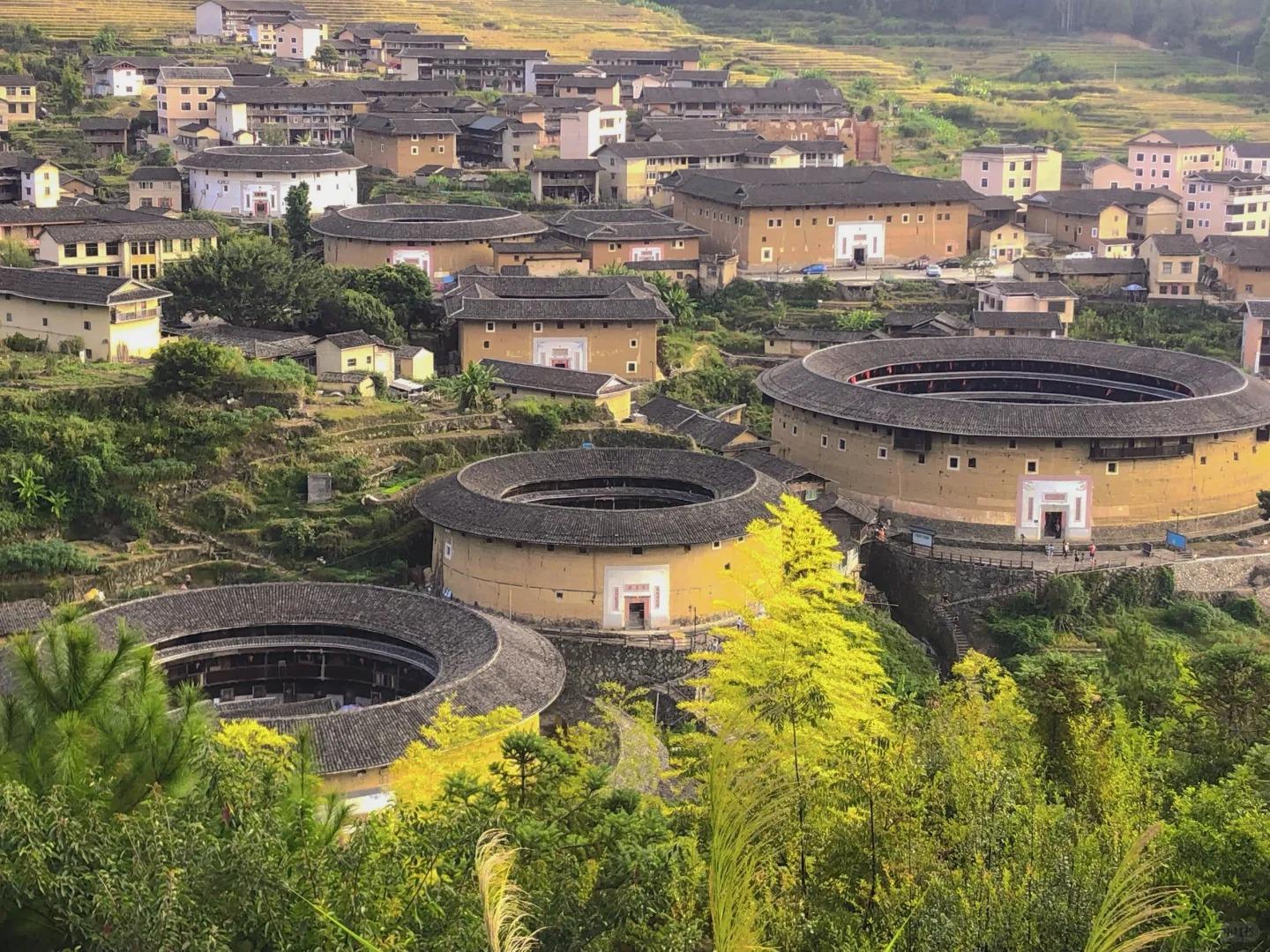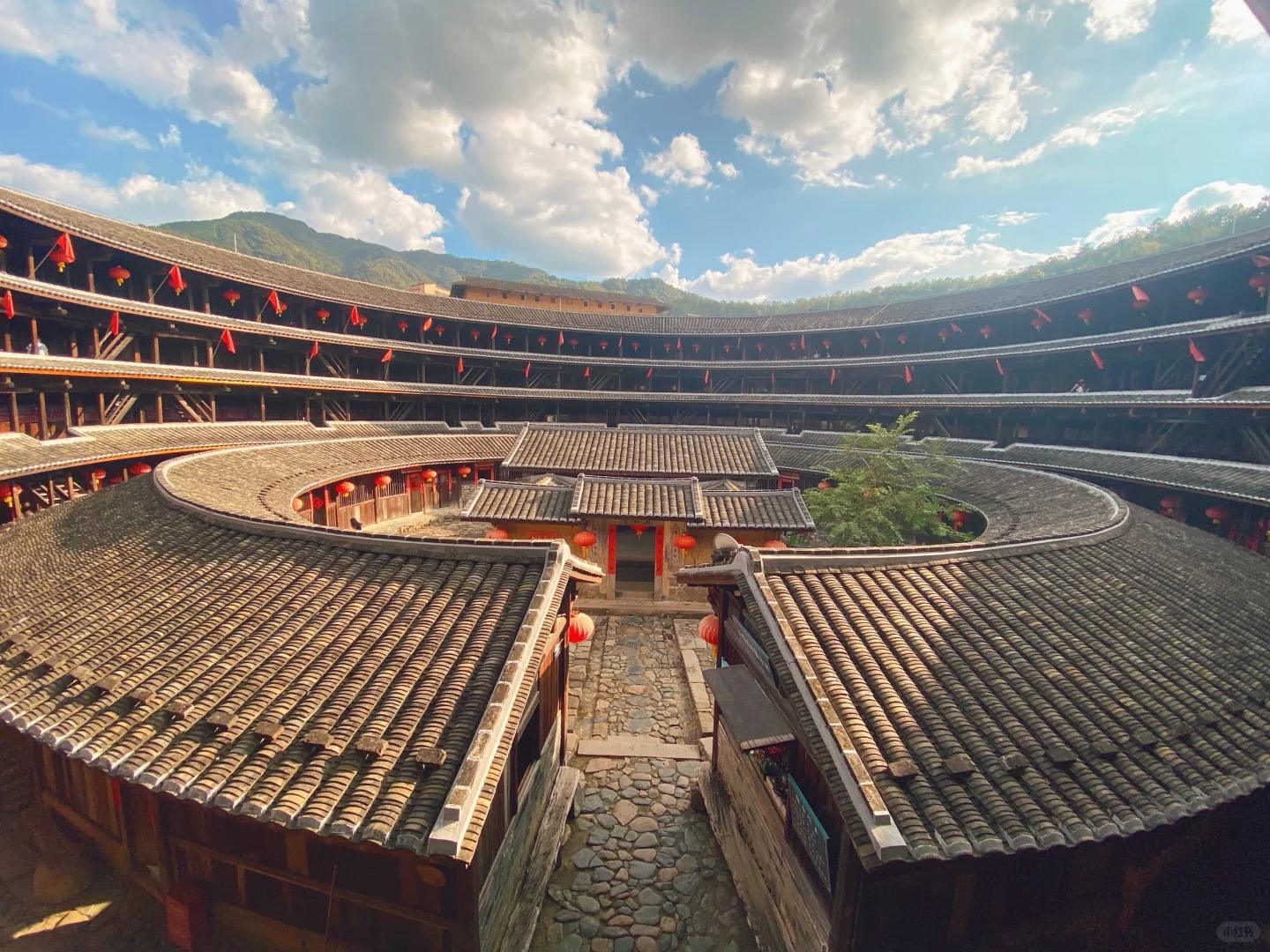Visiting Information
| Information | Details |
|---|---|
| Chinese Name | 福建土楼 (Fújiàn Tǔlóu) |
| Location and Address | Nanjing County, Zhangzhou City, Fujian Province, China |
| Opening Time/Hours | 8:00 AM – 5:30 PM (Daily) |
| Entrance Fee | CNY 100 (for the Nanjing Tulou Scenic Area) |
| How to Get There | By Bus: Take a bus from Xiamen to Nanjing County, then transfer to a local bus to the Tulou area By Taxi: From Xiamen, it’s about a 3-hour drive |
| Best Time for Visit | Spring (March to May) or Autumn (September to November) |
| Contact Info | +86 596 2501666 |
Overview
Fujian Tulou, also known as Hakka Tulou, are unique circular or square earthen buildings found in the mountainous areas of Fujian province in southeastern China. These remarkable structures, built between the 12th and 20th centuries, are a testament to the ingenuity of the Hakka people. Recognized as a UNESCO World Heritage Site in 2008, the Fujian Tulou are not only architectural marvels but also living examples of a communal lifestyle that has endured for centuries.
Historical Background
The Tulou buildings were primarily constructed by the Hakka people, who migrated from central China to the Fujian region during the Tang and Song dynasties (7th to 13th centuries). The design of these structures was a response to the need for defense against bandits and wild animals, as well as the desire to create a harmonious living environment for large, extended families. The oldest surviving Tulou dates back to the 13th century, while most of the existing structures were built during the Ming and Qing dynasties (14th to 20th centuries).

Architectural Features
- Circular or Square Design: Most Tulou are circular, though some are square or rectangular. The circular design provides maximum floor space with minimum building materials and offers better defensive capabilities. These structures can house up to 800 people.
- Thick Earthen Walls: The walls of a Tulou are typically 1.5 to 1.8 meters thick at the base, tapering slightly towards the top. They are made of a mixture of earth, sand, and lime, fortified with wooden strips, which provides excellent insulation and durability.
- Multi-story Structure: Tulou buildings are usually three to five stories high. The ground floor is typically used for kitchens and animal shelters, while the upper floors contain living quarters and storage areas.
- Central Courtyard: At the center of each Tulou is an open courtyard, often featuring a ancestral hall or community gathering space. This area serves as the heart of the community, used for meetings, celebrations, and daily activities.
- Single Entrance: Most Tulou have only one entrance, which can be easily guarded. This design feature was crucial for defense purposes in earlier times.
Cultural Importance
Fujian Tulou are not just architectural wonders but also embody the spirit of communal living and the Hakka culture. They represent a unique fusion of architectural ingenuity, environmental adaptation, and social organization. The Tulou reflect Confucian principles of equality and harmony, as all rooms within a Tulou are structurally identical, promoting a sense of community among residents. These buildings have played a crucial role in preserving Hakka traditions, customs, and way of life, serving as living museums of a rich cultural heritage.
Surrounding Attractions
- Taxia Village: Located near the Tulou clusters, Taxia Village is known for its picturesque setting along a river, surrounded by terraced fields. It offers visitors a glimpse into rural life in Fujian and is home to several well-preserved Tulou buildings.
- Tianluokeng Tulou Cluster: This famous cluster consists of five Tulou buildings arranged in a pattern resembling the Chinese character for “water” (水). It’s one of the most photographed Tulou sites and offers a stunning view of different Tulou architectural styles.
- Hongkeng Tulou Cluster: This area contains over 100 Tulou buildings, including the famous Zhencheng Lou, known as the “Prince of Tulou” due to its impressive size and intricate wooden carvings.

Photography Opportunities
- Aerial Views: Many Tulou clusters offer viewing platforms on nearby hills, providing excellent opportunities for panoramic shots that capture the unique circular or square shapes of the buildings nestled in the lush landscape.
- Interior Courtyards: The central courtyards of Tulou buildings offer interesting perspectives for photography, especially during early morning or late afternoon when the light creates dramatic shadows and highlights the architectural details.
- Daily Life Scenes: Many Tulou are still inhabited, providing opportunities to capture authentic moments of daily life, traditional activities, and the interaction between residents and their unique living environment.
Modern Importance
- Cultural Heritage Preservation: The UNESCO World Heritage status of Fujian Tulou has brought increased attention to the importance of preserving these unique structures. Ongoing conservation efforts aim to maintain the physical integrity of the buildings while also safeguarding the intangible cultural heritage associated with them.
- Sustainable Architecture Model: The eco-friendly design of Tulou, which provides natural temperature regulation and efficient use of space, has attracted interest from modern architects and urban planners looking for sustainable building solutions.
- Tourism Development: The Tulou have become a significant tourist attraction, contributing to the local economy and providing new opportunities for residents. This has led to a delicate balance between preserving authenticity and developing tourism infrastructure.
- Cultural Exchange: As a living example of traditional Chinese communal housing, the Tulou serve as a platform for cultural exchange, attracting researchers, architects, and cultural enthusiasts from around the world.

FAQ
- What is the Fujian Tulou famous for?
Fujian Tulou is famous for its unique circular or square earthen buildings that served as fortified village houses for Hakka people. They are renowned for their ingenious architectural design, communal living spaces, and their status as a UNESCO World Heritage site. - What’s inside the Fujian Tulou?
Inside a Fujian Tulou, you’ll find multiple stories of living quarters arranged around a central courtyard. The ground floor typically houses kitchens and animal shelters, while upper floors contain bedrooms and storage areas. Many Tulou also feature ancestral halls, community spaces, and sometimes small museums showcasing local history and culture. - Is the Fujian Tulou free?
No, the Fujian Tulou is not free to visit. There is an entrance fee of CNY 100 for the Nanjing Tulou Scenic Area, which includes access to several Tulou clusters. - Is the Fujian Tulou worth visiting?
Yes, the Fujian Tulou is definitely worth visiting. It offers a unique insight into traditional Chinese architecture, Hakka culture, and a communal way of life that has persisted for centuries. The picturesque setting and the impressive scale of these earthen structures make it a memorable experience for most visitors. - What to do in the Fujian Tulou?
At the Fujian Tulou, you can explore the various Tulou buildings, learn about their history and architecture, observe (and sometimes participate in) traditional Hakka activities, visit small museums within some Tulou, enjoy the scenic rural landscape, try local cuisine, and interact with residents who still inhabit some of these ancient structures. - How do I get to the Fujian Tulou in the local city?
To get to the Fujian Tulou from Xiamen (the nearest major city), you can take a long-distance bus from Xiamen to Nanjing County, which takes about 3 hours. From Nanjing County, you can then take a local bus to the Tulou scenic area. Alternatively, you can hire a taxi or join a tour group from Xiamen for a more convenient but pricier option. - How to visit the Fujian Tulou?
To visit the Fujian Tulou, it’s best to allow at least a full day, preferably two, to explore the various clusters. Start by visiting the Nanjing Tulou Scenic Area, which includes several famous Tulou clusters. Purchase your ticket at the entrance. Consider hiring a local guide for a more in-depth understanding of the history and culture. Wear comfortable shoes as there’s quite a bit of walking involved. Be respectful of the residents who still live in some Tulou. Try to visit early in the morning or late afternoon for the best lighting conditions if you’re interested in photography. Don’t forget to try local Hakka cuisine during your visit.



